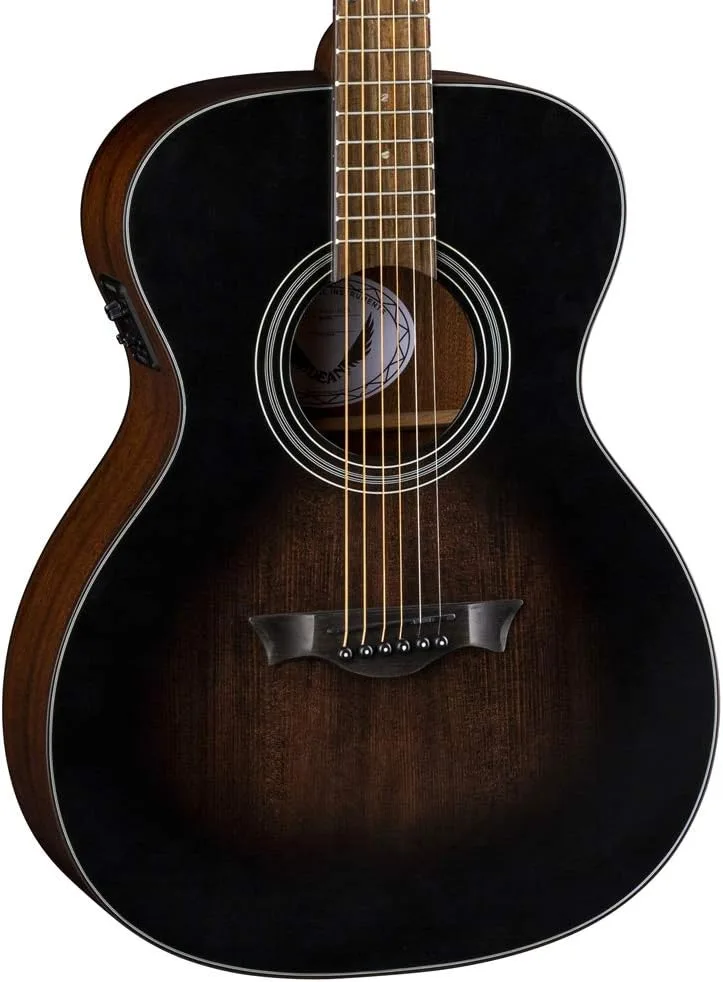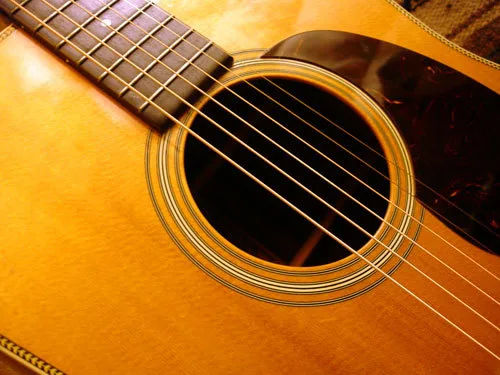Are you a guitar enthusiast struggling with the age-old question: do solid top guitars really sound better? As a fellow music lover, I understand your desire to find the perfect instrument for your playing style. And with so many contradicting opinions out there, it can be overwhelming to make a decision.
You may have heard that solid top guitars produce a richer and more resonant tone, while others argue that laminate top guitars are just as good. But which one is truly superior? As someone who has been studying and researching this topic for years, I’m here to finally put this debate to rest!
In this article, we’ll delve into the science behind guitar acoustics and compare the pros and cons of solid top vs laminate top guitars. Whether you’re an aspiring musician or simply looking to upgrade your current instrument, understanding these key differences will help you make an informed choice and find the perfect guitar for your needs. So let’s get started on uncovering the truth behind this popular debate!
So, Do solid top guitars sound better?
The answer to this question is subjective and ultimately depends on personal preference. While some people may argue that solid top guitars sound better, others may prefer the sound of a laminated top guitar. It’s important to understand the differences between these two types of guitars in order to make an informed decision.
A solid top guitar is made from one solid piece of wood for its soundboard, which is responsible for producing most of the instrument’s tone. This type of construction allows for more resonance and projection, resulting in a fuller and richer sound. On the other hand, a laminated top guitar has multiple layers of wood pressed together, with only the outer layer being made from solid wood. This can result in a slightly less resonant and brighter sound compared to a solid top guitar.
However, it’s worth noting that there are many factors that contribute to the overall sound quality of a guitar besides just its construction. The type and quality of materials used, as well as the craftsmanship and setup all play important roles in determining how a guitar will ultimately sound.
Ultimately, whether or not you believe solid top guitars sound better is up to personal preference. Some musicians may prefer the warmth and depth of tone produced by a solid top while others may enjoy the brightness and clarity provided by a laminated top. It’s always best to try out different guitars yourself before making any decisions based solely on popular debates or opinions online.
Understanding the Construction of Solid Top Guitars
When delving into the world of solid top guitars, it’s enchanting to uncover how these instruments are crafted. The top, often called the soundboard, is a vital component that greatly influences the guitar’s tone and resonance. Unlike laminate tops made from several thin layers of wood glued together, solid tops are created from a single piece or two pieces of high-quality wood like spruce or cedar. This method allows for better vibration and richer sound quality since there are no glue layers dampening the vibrations.
The woodworking process requires precision and skill. Crafting involves selecting premium wood with straight grain patterns for optimal strength and flexibility. Artisans then plane this wood to exact specifications so it achieves just the right thickness—neither too thick to stifle vibrations nor too thin to risk breakage. Bracing, usually made from lightweight but strong woods such as mahogany or maple, is meticulously attached underneath in intricate designs:
– Scalloped
– X-braced
– Fan braced
Each pattern adds unique qualities to the guitar’s overall sound.
In addition to fine-tuning acoustics through shape and material choice, luthiers pay close attention to aesthetic details like binding around edges and rosettes encircling sound holes. These embellishments aren’t just decorative; they contribute structural integrity
and prevent cracking over time. Owning a solid top guitar isn’t merely about playing music; it’s about holding an art form in your hands where craftsmanship meets auditory delight.
How Laminate Top Guitars are Made: A Detailed Look
The magic of laminate top guitars lies in their construction, a process that beautifully combines artistry and technology. Unlike solid wood guitars, these instruments feature layers of wood bonded together to form the soundboard. Typically, it begins with high-quality hardwood veneers such as spruce or maple for the outermost layer. These are chosen not just for their visual appeal but also for their tonal qualities. Beneath this veneer lie more layers—usually less expensive woods like mahogany or poplar—creating a sandwich-like structure.
Each layer is carefully treated and glued under pressure to ensure durability and optimal resonance. The gluing process involves applying even coats of adhesive between each veneer sheet before pressing them firmly together in molds designed to give shape to the guitar top. This multi-layered approach offers several benefits:
- Increased resistance to changes in humidity
- Enhanced structural integrity
- A more consistent tone across different environments
Once bonded, the laminated sheets are trimmed and shaped into what will become the face of the guitar body.
After shaping, craftsmen pay meticulous attention to detail by sanding down any rough edges and preparing the surface for finishing touches like staining or varnishing. The result is both aesthetically pleasing and functionally robust—a combination that makes laminate top guitars popular among musicians who seek reliability without compromising on style.
From there, it’s assembled with other parts including necks and hardware.
Read also: What is the difference between APX600 and CPX600

Comparing the Sound Quality between Solid and Laminate Top Guitars
When it comes to the world of guitars, one intriguing aspect is the difference in sound quality between solid and laminate tops. Solid top guitars are crafted from a single piece of wood, which allows for better vibration and resonance. This results in a tone that’s rich, full-bodied, and dynamic. The wood used can age over time, enriching the instrument’s sound further. When you strum or pluck these guitars, you often get a clearer and more articulate response that can capture nuances beautifully.
On the other hand, laminate top guitars, made by layering thin sheets of wood together with adhesives, offer their own unique benefits. While they might not provide as resonant or deep a sound as solid tops, they are generally more durable and less susceptible to changes in humidity and temperature—perfect for travel or beginners who may not be attuned to maintaining an instrument meticulously. Laminate tops tend to produce a consistent tone that’s still enjoyable but lacks some of the complexity found in solid top counterparts.
- Durability: Laminate > Solid
- Tonal Richness: Solid > Laminate
- Aging Benefits: Solid > Laminate
In essence, your choice boils down to what values resonate most with your needs—whether it’s tonal excellence or rugged durability.
The Role of Individual Playing Styles in Determining Guitar Design Choice
Guitar design and individual playing styles often go hand in hand, shaping the instrument a player selects. Every guitarist has their own unique style that blossoms from personal preferences, musical influences, and physical comfort. This uniqueness means that what works for one player might not suit another at all. A metalhead shredding lightning-fast solos would likely lean towards an electric guitar with a slim neck for quick finger movements, like those designed by Ibanez or Jackson. In contrast, a folk musician strumming soothing melodies may prefer the warm resonance of an acoustic guitar with wider frets and thicker strings.
In many ways, the choice of guitar is both deeply personal and profoundly practical. Players who favor complex fingerpicking techniques need instruments that allow them to produce clear notes even when multiple strings are plucked simultaneously; thus, they might look for guitars with responsive soundboards and excellent action settings. Meanwhile,
those who thrive on bluesy bends and expressive vibratos will appreciate instruments equipped with lighter gauge strings or tremolo systems.
Here’s where details matter:
- The shape of the body affects how comfortably one can hold it.
- The type of wood influences the tone produced.
- The position of pickups determines how well each note is captured.
All these elements come together to create a symphony between the player’s fingers and their chosen ax—each note becoming an extension of their individuality through carefully selected design choices.
You may also like: Why do rich people own pianos
Making an Informed Decision on Your Next Guitar Purchase
When thinking about buying a new guitar, it’s easy to get lost in all the options. You walk into a music store or browse online and see so many shapes, colors, and brands. The choices can be overwhelming! But don’t fret, taking some time to understand your needs will help you make a better decision.
Firstly, consider what type of guitar fits your style:
- Acoustic: Great for singer-songwriters who love unplugged sessions.
- Electric: Perfect if you’re into genres like rock or jazz and enjoy effects pedals.
- Bass: Ideal for those who want to lay down the groove in any band setting.
Once you’ve chosen the type, think about your budget. Guitars range from affordable beginner models to high-end masterpieces costing thousands.
Next up is comfort. Go try out different guitars at a music shop if possible. Notice how each one feels in your hands—weight distribution matters more than you might think! Look at the neck’s shape; it should fit comfortably as you play chords and scales. Also, pay attention to details like string height (action) because they’ll affect how easy it is to press down on notes.
Finally, read reviews online from other musicians but take them with a grain of salt. Everyone has their preferences which may not match yours exactly.
By taking these steps thoughtfully, you’ll find that special instrument calling out just for you.
“Happy strumming!”

